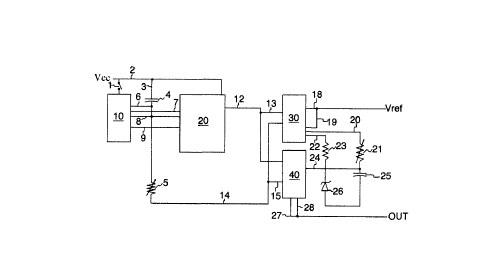Une partie des informations de ce site Web a été fournie par des sources externes. Le gouvernement du Canada n'assume aucune responsabilité concernant la précision, l'actualité ou la fiabilité des informations fournies par les sources externes. Les utilisateurs qui désirent employer cette information devraient consulter directement la source des informations. Le contenu fourni par les sources externes n'est pas assujetti aux exigences sur les langues officielles, la protection des renseignements personnels et l'accessibilité.
L'apparition de différences dans le texte et l'image des Revendications et de l'Abrégé dépend du moment auquel le document est publié. Les textes des Revendications et de l'Abrégé sont affichés :
| (12) Demande de brevet: | (11) CA 3039987 |
|---|---|
| (54) Titre français: | CIRCUIT DE COMMANDE DE DEMARRAGE ET DE VITESSE AUTOMATIQUE |
| (54) Titre anglais: | AUTOMATIC START AND SPEED COMMAND CIRCUIT |
| Statut: | Conforme |
| (51) Classification internationale des brevets (CIB): |
|
|---|---|
| (72) Inventeurs : |
|
| (73) Titulaires : |
|
| (71) Demandeurs : |
|
| (74) Agent: | |
| (74) Co-agent: | |
| (45) Délivré: | |
| (22) Date de dépôt: | 2019-04-10 |
| (41) Mise à la disponibilité du public: | 2020-10-10 |
| Licence disponible: | S.O. |
| (25) Langue des documents déposés: | Anglais |
| Traité de coopération en matière de brevets (PCT): | Non |
|---|
| (30) Données de priorité de la demande: | S.O. |
|---|
Automatic start and speed command circuit for supplying an analog start
acceleration and preset signal to an AC electric motor controlled by a
variable frequency motor and or brushed/brushless DC motor controller or
any electric motor speed control or drive which uses an analog speed
command signal input for supplying a variable analog speed command to
the controller for setting an operational motor speed. This includes
manually speed setting device such as potentiometer.
Automatic start and speed command circuit will provide a cycle start after
which will increase the command to said electric analog drive to accelerate
the motor for an allotted time to allow the controller and motor to
achieve the commanded speed at the motor, the speed command is
incrementally increased till maximum speed or set speed is
achieved.
A adjustable time base is included for each increase of command speed
to allow for tuning the start up performance of the motor. An isolated
power source is included which provides power to the circuit and is
isolated from the command signal on the drive or controller as not to
interfere with input command on the drive and/or controller.
Note : Les revendications sont présentées dans la langue officielle dans laquelle elles ont été soumises.
Note : Les descriptions sont présentées dans la langue officielle dans laquelle elles ont été soumises.

Pour une meilleure compréhension de l'état de la demande ou brevet qui figure sur cette page, la rubrique Mise en garde , et les descriptions de Brevet , États administratifs , Taxes périodiques et Historique des paiements devraient être consultées.
| Titre | Date |
|---|---|
| Date de délivrance prévu | Non disponible |
| (22) Dépôt | 2019-04-10 |
| (41) Mise à la disponibilité du public | 2020-10-10 |
Il n'y a pas d'historique d'abandonnement
Dernier paiement au montant de 50,00 $ a été reçu le 2020-04-27
Montants des taxes pour le maintien en état à venir
| Description | Date | Montant |
|---|---|---|
| Prochain paiement si taxe applicable aux petites entités | 2024-04-10 | 100,00 $ |
| Prochain paiement si taxe générale | 2024-04-10 | 277,00 $ |
Avis : Si le paiement en totalité n'a pas été reçu au plus tard à la date indiquée, une taxe supplémentaire peut être imposée, soit une des taxes suivantes :
Les taxes sur les brevets sont ajustées au 1er janvier de chaque année. Les montants ci-dessus sont les montants actuels s'ils sont reçus au plus tard le 31 décembre de l'année en cours.
Veuillez vous référer à la page web des
taxes sur les brevets
de l'OPIC pour voir tous les montants actuels des taxes.
| Type de taxes | Anniversaire | Échéance | Montant payé | Date payée |
|---|---|---|---|---|
| Le dépôt d'une demande de brevet | 200,00 $ | 2019-04-10 | ||
| Taxe de maintien en état - Demande - nouvelle loi | 2 | 2021-04-12 | 50,00 $ | 2020-04-27 |
| Taxe de maintien en état - Demande - nouvelle loi | 3 | 2022-04-11 | 50,00 $ | 2020-04-27 |
| Taxe de maintien en état - Demande - nouvelle loi | 4 | 2023-04-11 | 50,00 $ | 2020-04-27 |
Les titulaires actuels et antérieures au dossier sont affichés en ordre alphabétique.
| Titulaires actuels au dossier |
|---|
| MASTROMATTEI, ANTHONY |
| MASTROMATTEI, JORDAN LUIGI |
| MASTROMATTEI, ROBERT ALDO |
| Titulaires antérieures au dossier |
|---|
| S.O. |